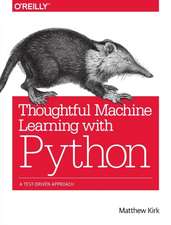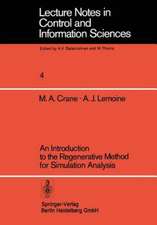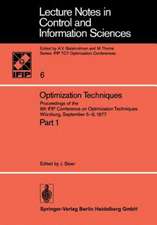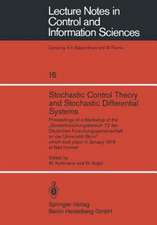Handbook of Natural Computing
Editat de Grzegorz Rozenberg, Thomas Bäck, Joost N. Koken Limba Engleză Hardback – 9 iul 2012
Examples of the first strand of research covered by the handbook include neural computation inspired by the functioning of the brain; evolutionary computation inspired by Darwinian evolution of species; cellular automata inspired by intercellular communication; swarm intelligence inspired by the behavior of groups of organisms; artificial immune systems inspired by the natural immune system; artificial life systems inspired by the properties of natural life in general; membrane computing inspired by the compartmentalized ways in which cells process information; and amorphous computing inspired by morphogenesis. Other examples of natural-computing paradigms are molecular computing and quantum computing, where the goal is to replace traditional electronic hardware, e.g., by bioware in molecular computing. In molecular computing, data are encoded as biomolecules and then molecular biology tools are used to transform the data, thus performing computations. In quantum computing, one exploits quantum-mechanical phenomena to perform computations and secure communications more efficiently than classical physics and, hence, traditional hardware allows.
The second strand of research covered by the handbook, computation taking place in nature, is represented by investigations into, among others, the computational nature of self-assembly, which lies at the core of nanoscience, the computational nature of developmental processes, the computational nature of biochemical reactions, the computational nature of bacterial communication, the computational nature of brain processes, and the systems biology approach to bionetworks where cellular processes aretreated in terms of communication and interaction, and, hence, in terms of computation.
We are now witnessing exciting interaction between computer science and the natural sciences. While the natural sciences are rapidly absorbing notions, techniques and methodologies intrinsic to information processing, computer science is adapting and extending its traditional notion of computation, and computational techniques, to account for computation taking place in nature around us. Natural Computing is an important catalyst for this two-way interaction, and this handbook is a major record of this important development.
Preț: 6450.05 lei
Preț vechi: 8062.55 lei
-20% Nou
Puncte Express: 9675
Preț estimativ în valută:
1234.36€ • 1340.34$ • 1036.86£
1234.36€ • 1340.34$ • 1036.86£
Carte tipărită la comandă
Livrare economică 18-24 aprilie
Preluare comenzi: 021 569.72.76
Specificații
ISBN-13: 9783540929093
ISBN-10: 3540929096
Pagini: 2100
Ilustrații: LII, 2052 p. 332 illus., 60 illus. in color.
Dimensiuni: 155 x 235 x 145 mm
Greutate: 3.72 kg
Ediția:2012
Editura: Springer Berlin, Heidelberg
Colecția Springer
Locul publicării:Berlin, Heidelberg, Germany
ISBN-10: 3540929096
Pagini: 2100
Ilustrații: LII, 2052 p. 332 illus., 60 illus. in color.
Dimensiuni: 155 x 235 x 145 mm
Greutate: 3.72 kg
Ediția:2012
Editura: Springer Berlin, Heidelberg
Colecția Springer
Locul publicării:Berlin, Heidelberg, Germany
Public țintă
ResearchCuprins
Neural Computing; Evolutionary Computing; Molecular Computing; Quantum Computing; Cellular Automata; Broader Perspective.
Recenzii
“I am delighted to be able to recommend this amazingly broad and comprehensive four-volume handbook. Natural Computing is here to stay. It is already becoming a central theme on the borderline between computer science, mathematics and biology, and is poised to play a crucial role in 21st Century science. Grzegorz Rozenberg, besides being a superb scientist and thinker (and an astonishing magician too!), has the uncanny ability to bring together the best people and to somehow get them to contribute to important efforts. This handbook is one of his crowning achievements, and I salute both him and the wonderful result.” [David Harel, Weizmann Institute of Science]
“The Handbook covers in a comprehensive and superb manner all central areas of natural computing. The term Natural Computing was coined by the Main Editor of the Handbook, Grzegorz Rozenberg, some thirty years ago to refer to human-designed computing inspired by nature, as well as computing actually taking place in nature. The main areas of the field (Cellular Automata, Neural Computation, Evolutionary Computation, Molecular Computation, Quantum Computation) are each subedited by top experts. Insights into other areas as well as hints to the future are provided in the part 'Broader Perspectives'. The number of contributors, 105, is amazing. The total result is an excellent massive set of four volumes that will constitute a unique source of reference for researchers and students for a long time to come.” [Arto Salomaa, Academy of Finland]
“Natural sciences aim at discovery while technology seeks invention, thus the interplay of the two fosters creativity and is crucial for the advancement of knowledge. This timely Handbook is a vast effort to compile and relate what is known today about understanding nature through computation and about devising new models, techniques, and technologies of computation inspired by natural phenomena. As a pioneering and seminal work, it constitutes a magnificent entry point for those looking for an exciting research field, and I am sure it will become a reference pillar for the years to come.” [Carme Torras, Institut de Robòtica i Informàtica Industrial (CSIC-UPC), Barcelona]
“[The Handbook] is an achievement of excellent editing. The topics covered are widely disparate and there are dozens of authors involved, and yet the editors have produced a beautifully coordinated, balanced, and very readable resource. All the contributions are very well written, and moreover very well illustrated, and the individual chapters seem able to balance depth of coverage with accessibility. While the mathematical underpinning is rigorous, the clear text and the graphics make it possible for nonexperts to understand the topics with a reasonable effort. ... The many chapters in the various sections of this book show different aspects of the overall approach. Some chapters give a flavor of their topics in an informalmanner, others explain the mathematics, while still others show how the topics can be applied. The emphasis throughout seems to be to explain the concepts without too many implementation details. The tone and clarity are consistent throughout, which makes it possible to read consecutive chapters without noticing any change in style or authorship. Each chapter also includes a good list of references for further study. ... I found it really inspiring to browse through all four volumes together, as it helps to get details of any one approach while having a view of the wider context. ... It provides a solid, easy-to-digest foundation for topics of increasing importance, and the grouping of chapters into related parts provides far more information than individual chapters could.” [Sara Kalvala, ACM Computing Reviews, 2013]
“This work provides a solid presentation of both aspects of computing–natural and artificial–and serves as an important foundation and cross-fertilization for researchers in each area, although the emphasis is still primarily on nature-inspired artificial algorithms. … The book is inspirational in its coverage of the subject. It will be an indispensable tool for researchers and practitioners interested in developing nature-inspired algorithms and a valuable resource for research institutions. Summing Up: Highly recommended. Graduate students and above.” [J. Y. Cheung, Choice, Vol. 50 (5), January, 2013]
“The Handbook covers in a comprehensive and superb manner all central areas of natural computing. The term Natural Computing was coined by the Main Editor of the Handbook, Grzegorz Rozenberg, some thirty years ago to refer to human-designed computing inspired by nature, as well as computing actually taking place in nature. The main areas of the field (Cellular Automata, Neural Computation, Evolutionary Computation, Molecular Computation, Quantum Computation) are each subedited by top experts. Insights into other areas as well as hints to the future are provided in the part 'Broader Perspectives'. The number of contributors, 105, is amazing. The total result is an excellent massive set of four volumes that will constitute a unique source of reference for researchers and students for a long time to come.” [Arto Salomaa, Academy of Finland]
“Natural sciences aim at discovery while technology seeks invention, thus the interplay of the two fosters creativity and is crucial for the advancement of knowledge. This timely Handbook is a vast effort to compile and relate what is known today about understanding nature through computation and about devising new models, techniques, and technologies of computation inspired by natural phenomena. As a pioneering and seminal work, it constitutes a magnificent entry point for those looking for an exciting research field, and I am sure it will become a reference pillar for the years to come.” [Carme Torras, Institut de Robòtica i Informàtica Industrial (CSIC-UPC), Barcelona]
“[The Handbook] is an achievement of excellent editing. The topics covered are widely disparate and there are dozens of authors involved, and yet the editors have produced a beautifully coordinated, balanced, and very readable resource. All the contributions are very well written, and moreover very well illustrated, and the individual chapters seem able to balance depth of coverage with accessibility. While the mathematical underpinning is rigorous, the clear text and the graphics make it possible for nonexperts to understand the topics with a reasonable effort. ... The many chapters in the various sections of this book show different aspects of the overall approach. Some chapters give a flavor of their topics in an informalmanner, others explain the mathematics, while still others show how the topics can be applied. The emphasis throughout seems to be to explain the concepts without too many implementation details. The tone and clarity are consistent throughout, which makes it possible to read consecutive chapters without noticing any change in style or authorship. Each chapter also includes a good list of references for further study. ... I found it really inspiring to browse through all four volumes together, as it helps to get details of any one approach while having a view of the wider context. ... It provides a solid, easy-to-digest foundation for topics of increasing importance, and the grouping of chapters into related parts provides far more information than individual chapters could.” [Sara Kalvala, ACM Computing Reviews, 2013]
“This work provides a solid presentation of both aspects of computing–natural and artificial–and serves as an important foundation and cross-fertilization for researchers in each area, although the emphasis is still primarily on nature-inspired artificial algorithms. … The book is inspirational in its coverage of the subject. It will be an indispensable tool for researchers and practitioners interested in developing nature-inspired algorithms and a valuable resource for research institutions. Summing Up: Highly recommended. Graduate students and above.” [J. Y. Cheung, Choice, Vol. 50 (5), January, 2013]
Textul de pe ultima copertă
Natural Computing is the field of research that investigates both human-designed computing inspired by nature and computing taking place in nature, i.e., it investigates models and computational techniques inspired by nature and also it investigates phenomena taking place in nature in terms of information processing.
Examples of the first strand of research covered by the handbook include neural computation inspired by the functioning of the brain; evolutionary computation inspired by Darwinian evolution of species; cellular automata inspired by intercellular communication; swarm intelligence inspired by the behavior of groups of organisms; artificial immune systems inspired by the natural immune system; artificial life systems inspired by the properties of natural life in general; membrane computing inspired by the compartmentalized ways in which cells process information; and amorphous computing inspired by morphogenesis. Other examples of natural-computing paradigms are molecular computing and quantum computing, where the goal is to replace traditional electronic hardware, e.g., by bioware in molecular computing. In molecular computing, data are encoded as biomolecules and then molecular biology tools are used to transform the data, thus performing computations. In quantum computing, one exploits quantum-mechanical phenomena to perform computations and secure communications more efficiently than classical physics and, hence, traditional hardware allows.
The second strand of research covered by the handbook, computation taking place in nature, is represented by investigations into, among others, the computational nature of self-assembly, which lies at the core of nanoscience, the computational nature of developmental processes, the computational nature of biochemical reactions, the computational nature of bacterial communication, the computational nature of brain processes, and the systems biology approach to bionetworks where cellular processes aretreated in terms of communication and interaction, and, hence, in terms of computation.
We are now witnessing exciting interaction between computer science and the natural sciences. While the natural sciences are rapidly absorbing notions, techniques and methodologies intrinsic to information processing, computer science is adapting and extending its traditional notion of computation, and computational techniques, to account for computation taking place in nature around us. Natural Computing is an important catalyst for this two-way interaction, and this handbook is a major record of this important development.
Examples of the first strand of research covered by the handbook include neural computation inspired by the functioning of the brain; evolutionary computation inspired by Darwinian evolution of species; cellular automata inspired by intercellular communication; swarm intelligence inspired by the behavior of groups of organisms; artificial immune systems inspired by the natural immune system; artificial life systems inspired by the properties of natural life in general; membrane computing inspired by the compartmentalized ways in which cells process information; and amorphous computing inspired by morphogenesis. Other examples of natural-computing paradigms are molecular computing and quantum computing, where the goal is to replace traditional electronic hardware, e.g., by bioware in molecular computing. In molecular computing, data are encoded as biomolecules and then molecular biology tools are used to transform the data, thus performing computations. In quantum computing, one exploits quantum-mechanical phenomena to perform computations and secure communications more efficiently than classical physics and, hence, traditional hardware allows.
The second strand of research covered by the handbook, computation taking place in nature, is represented by investigations into, among others, the computational nature of self-assembly, which lies at the core of nanoscience, the computational nature of developmental processes, the computational nature of biochemical reactions, the computational nature of bacterial communication, the computational nature of brain processes, and the systems biology approach to bionetworks where cellular processes aretreated in terms of communication and interaction, and, hence, in terms of computation.
We are now witnessing exciting interaction between computer science and the natural sciences. While the natural sciences are rapidly absorbing notions, techniques and methodologies intrinsic to information processing, computer science is adapting and extending its traditional notion of computation, and computational techniques, to account for computation taking place in nature around us. Natural Computing is an important catalyst for this two-way interaction, and this handbook is a major record of this important development.
Caracteristici
We are now witnessing exciting interaction between computer science and the natural sciences. Natural Computing is an important catalyst for this interaction, and this handbook is a major record of this important development. Includes supplementary material: sn.pub/extras






















